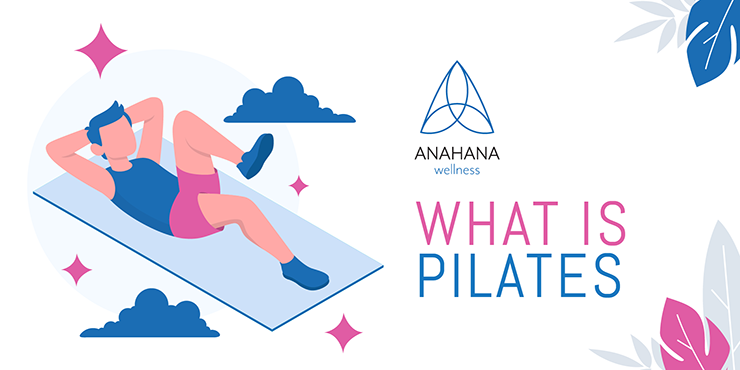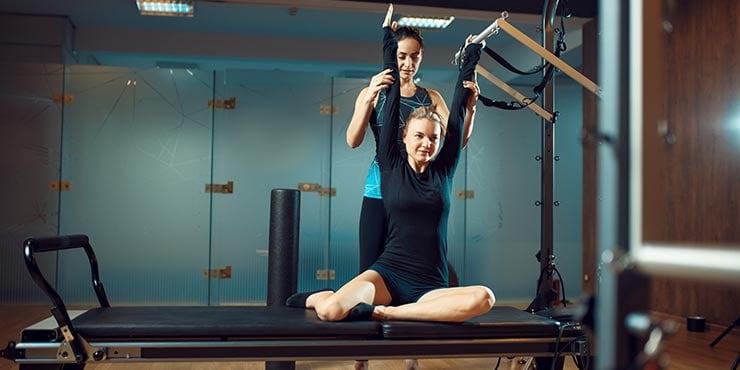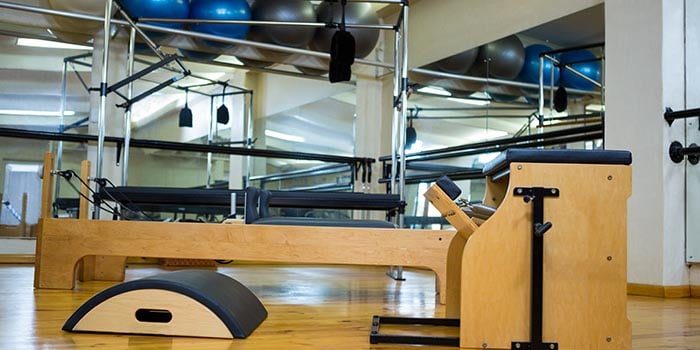Pilates
The Pilates method is the practice of low-impact mind body exercise that aims to strengthen muscles while improving posture and flexibility. Pilates...
There is an extensive range of Pilates equipment on the market today. Some pieces include reformer boxes, Pilates sticks, rollers, and Pilates chairs. Once an individual has learned the foundational Pilates movements often used in a mat practice, they can then utilize these same exercises with other pieces of equipment to enhance or modify their workouts.
 Besides all the different types of equipment mentioned, it is also important to mention the vast array of Pilates reformers available.
Besides all the different types of equipment mentioned, it is also important to mention the vast array of Pilates reformers available.
Pilates props and equipment are used for all types of different situations. For example, if someone is just starting and taking a class, they may use a Pilates reformer at a studio.
Alternatively, many Pilates instructors specialize in mat Pilates, in which case only a mat and perhaps a few props will be needed. Props that may be used in a mat class include a foam roller, a Pilates ring, and/or Pilates socks for grip on the mat.
Both Pilates and yoga use mats for their practices, but the mats used are not the same because of the way the different movements are done. Yoga uses a thin mat while Pilates uses a mat that is softer, thicker, longer, and wider.
This accommodates the different ages and levels of the individuals who workout using the Pilates method helping make it suitable for everyone. The thicker mat makes it more comfortable to do different exercises such as roll-ups and being on hands and knees in four-point.
Other Pilates equipment includes stability chairs, spine correctors, stability barres, halo trainer plus, fitness circles (also known as a magic circle), a Pilates ball, resistance bands, reformer boxes, rollers, Pilates sticks, ankle weights, and foam rollers.
Pilates equipment is used to both increase and decrease the difficulty of Pilates movements. It is what allows the Pilates practice to be suitable for all ages and abilities. The different equipment and accessories can assist in several ways including helping with balance, providing feedback (tactile, visual, and proprioceptive), increasing an individual's confidence, and making an exercise more comfortable or safer.
It depends on several factors such as the individual's ability, skill, and fitness levels, the difficulty level of the Pilates exercises, and the type of Pilates class. Some equipment can make the process of Pilates easier, and some props can provide more of a challenge. For an individual to decide what pieces of Pilates equipment are appropriate for them, they must first determine what their goals are.
If the goals are to do vigorous exercise and to lose extra weight, for example, it may be best to purchase a reformer and additional reformer props such as reformer boxes. These can help enhance the workout to work towards that goal.
If someone has the goal of starting a Pilates practice and they are a complete beginner, they would consider simply purchasing a Pilates mat and some Pilates socks to mitigate slipping. This is a simple way to go for those just starting.
Finally, do not forget about Pilates clothes, like leggings, a comfortable top, and/or a sports bra. Comfortable clothing is important when performing any type of exercise including Pilates workouts. Clothes are props that are a must for a Pilates workout, no matter what.
For those serious about the Pilates method, a classic piece of equipment is a Pilates reformer. A Pilates reformer is a great machine that has a mobile platform or carriage that has adjustable springs attached to it. The springs are used to add resistance similar to using a cable machine with weights attached. It also has straps and a foot bar to do different exercises in a controlled manner for a full-body workout including muscles of the arms, core, and legs. Options such as a platform extender are available for taller individuals.
Exercises that are completed on a mat can also be done on a reformer. All the same benefits are achieved. Doing exercises on a reformer often increases the difficulty and challenges balance by changing the proprioceptive component of the exercise due to the increased demands of being on a moving reformer platform compared to a stable mat.
Pilates reformers range from highly expensive models to less expensive and from professional grade to personal models that can be used in a home gym. Reformers from companies like Stott Pilates and Balanced Body are usually found at a studio due to their higher price point while a mini reformer from Pilates Power Gym is often bought for home use.
If just starting, an individual could consider purchasing a less expensive model with good reviews. If they end up liking reformer work, they can always upgrade.
The best Pilates reformer is the one that fits the individual's needs. This means one that fits their budget as well as any other features required to help them meet their goals.
When using a reformer at home, especially when someone is new to using a reformer or the Pilates method, having an instructor to guide the workout is important. This can help decrease the risk of injury as well as help with better posture and alignment while doing exercises.
A Pilates reformer is not the only option available, there are many different Pilates equipment pieces that can greatly help someone's practice. Likely, the most important of these would be the Pilates mat.
Having a Pilates mat at home allows the opportunity to practice any type of mat practice, including numerous core exercises to improve core strength and other body weight movements. It can also be used in yoga and other fitness programs as well.
Different equipment is key for both studio and home workouts. A piece of equipment can adjust a Pilates exercise based on the goal of the fitness practice to deliver results. It can help enhance or modify exercises to find the right level of difficulty or the right resistance for an individual by increasing or decreasing the challenge of the exercise.
Individuals may use Pilates props and equipment for many different reasons:
Pilates workouts are beneficial for individuals pre and post-natal. During pregnancy, a common side effect is back pain due to the changes that occur to the body affecting posture.
Equipment that helps support the body as well as focuses on postural alignment such as a spine corrector may be appropriate to use during pregnancy and after giving birth. Pilates equipment has padding such as a padded cushion and can be adjusted in numerous ways to help increase support and comfort. This is what makes Pilates suitable for everyone.
Attending a specific pre or post-natal class led by a certified Pilates instructor can decrease the chance of injury. It can also ensure that exercise modification can be provided when needed.

A Pilates fitness workout can be safe and beneficial for everyone. This includes individuals who have had hip replacements or knee replacements as well as those who have injuries due to sport or day-to-day activity or even chronic pain.
A Pilates workout can be modified or adjusted to meet the individual's needs. By using Pilates equipment, an exercise can be made safer or can protect someone from further injury or a future injury. This can be done at home or in the studio with a certified Pilates instructor.
Many different pieces of Pilates equipment can be used during a fitness workout such as a Pilates ball, a magic circle, a foam roller, ankle weights, a reformer, or an arc barrel. The best Pilates equipment is that that is chosen specifically for an individual by a certified Pilates instructor.
Movements can be modified or enhanced by using different equipment. A stability ball can be used to decrease the difficulty of an exercise while a reformer can be used to increase the difficulty due to its moving surface.
Some movements can be modified just by changing the position of the body. They can also be adjusted by helping activate different muscles, for example, by adding a resistance band around the legs during a bridge sequence.
When doing a fitness workout on a mat, kneeling moves are less difficult than standing moves due to increased stability. Similar adjustments can be made during reformer Pilates. An example would be dropping down to the elbows when performing bird dog in reformer Pilates instead of supporting the upper body on the hands.
Whether the Pilates method is practiced at home with a digital subscription, one-on-one with a teacher, or in a studio with other people, it is ideal to purchase at least a few Pilates props.
Aside from Pilates reformers, which are undoubtedly the most popular type of equipment for Pilates, consider purchasing additional props such as foam rollers, Pilates socks for grip, a magic circle, resistance bands, and a Pilates chair.
Pilates reformers are not necessarily required to start a Pilates practice. It all depends on an individual's fitness goals, their comfort level with various types of equipment, what types of classes they are taking, and their budget. All the benefits that can be achieved using a reformer can also be achieved by practicing on a mat.
Owning a reformer for home fitness is certainly a viable option, but mat classes can also be practiced at home. In this case, a Pilates reformer is not needed, and the only prop required is a mat. Both workouts will provide similar benefits.
As with many fitness props, a lot or very little can be spent on equipment to get the best Pilates workout. The most expensive type of Pilates equipment is the reformer.
Pilates reformers are easily more than $1000 and sometimes many thousands of dollars more (like some Balanced Body reformer options). If buying a reformer for home use, look for a balance between quality and cost as reformers are an investment.
For serious Pilates enthusiasts, having a reformer is key.
Of course, a Pilates reformer is not necessary. Pilates workouts can still be done at home simply with a mat and a certified Pilates instructor. A Pilates instructor can help ensure proper form is being used. To enhance a Pilates workout, consider adding props like mats, weights, balls, rings, and foam rollers. Most bands and weights come in varying resistances to meet the needs of the individual.
Check out local Pilates studios to see if they offer Pilates reformer classes. If unable to take a reformer class at a Pilates studio nearby, consider a virtual Pilates reformer class.
If opting for a virtual digital Pilates course a home Pilates reformer will be required. Still, choosing a digital class has its benefits. Most importantly, it can provide flexibility with scheduling practices and increase the chances of maintaining a Pilates workout routine.
Pilates Reformer Machines - Ultimate in Quality | Merrithew™
Pilates Exercise Equipment - Professional & Home | Merrithew™
Reformer Pilates: the Secret to Faster Results?
Pilates and yoga - health benefits

The Pilates method is the practice of low-impact mind body exercise that aims to strengthen muscles while improving posture and flexibility. Pilates...

Pilates is a form of resistance training that originated in Germany. Joseph Pilates created it in the 1920s for rehabilitation for war soldiers, and...

There is an extensive range of Pilates equipment on the market today. Some pieces include reformer boxes, Pilates sticks, rollers, and Pilates...